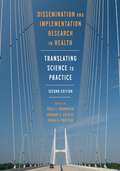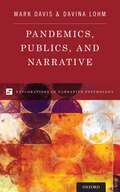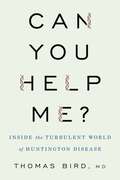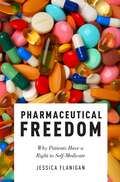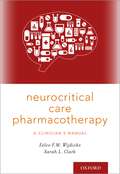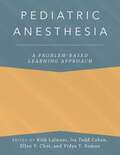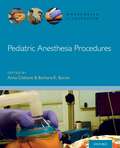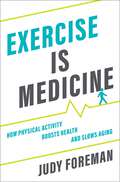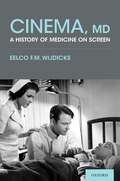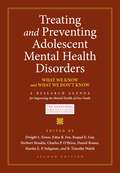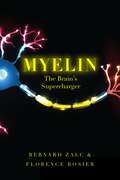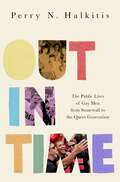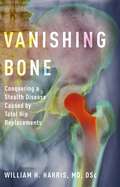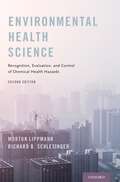- Table View
- List View
Dissemination and Implementation Research in Health: Translating Science to Practice
by Ross C. Brownson, Graham A. Colditz and Enola K. ProctorThe definitive work in D&I research -- now completely updated and expanded The application of scientific research to the creation of evidence-based policies is a science unto itself -- and one that is never easy. Dissemination and implementation research (D&I) is the study of how scientific advances can be implemented into everyday life, and understanding how it works has never been more important for students and professionals across the scientific, academic, and governmental communities. DISSEMINATION AND IMPLEMENTATION RESEARCH IN HEALTH is a practical guide to making research more consequential, a collection assembled and written by today's leading D&I researchers. Readers of this book are taught to: · Evaluate the evidence base in an effective intervention · Choose a strategy that produces the greatest impact · Design an appropriate and effectual study · Track essential outcomes · Account for the barriers to uptake in communities, social service agencies, and health care facilities The challenges to moving research into practice are universal, and they're complicated by the current landscape's reliance on partnerships and multi-center research. In this light, DISSEMINATION AND IMPLEMENTATION RESEARCH IN HEALTH is nothing less than a roadmap to effecting change in the sciences. It will have broad utility to researchers and practitioners in epidemiology, biostatistics, behavioral science, economics, medicine, social work, psychology, and anthropology -- both today and in our slightly better future.
Pandemics, Publics, and Narrative (Explorations in Narrative Psychology)
by Mark Davis Davina LohmResearch suggests that future influenza pandemics are inevitable as strains of the virus mutate in new ways. With this uncomfortable reality in mind, this book examines how the general public experienced the 2009 H1N1 influenza virus outbreak by bringing together stories about individuals' perception of their illness, as well as reflections on news, vaccination, social isolation, and other infection control measures. The book also charts the story-telling of public life, including the 'be alert, not alarmed' messages from the beginning of the outbreak through to the narratives that emerged later when the virus turned out to be less serious than initially thought. Providing unprecedented insight into the lives of ordinary people faced with the specter of a potentially lethal virus and drawing on currents in sociocultural scholarship of narrative, illness narrative, and narrative medicine, Pandemics, Publics, and Narrative develops a novel 'public health narrative' approach of interest to health communicators and researchers across the social and health sciences.
Pandemics, Publics, and Narrative (Explorations in Narrative Psychology)
by Mark Davis Davina LohmResearch suggests that future influenza pandemics are inevitable as strains of the virus mutate in new ways. With this uncomfortable reality in mind, this book examines how the general public experienced the 2009 H1N1 influenza virus outbreak by bringing together stories about individuals' perception of their illness, as well as reflections on news, vaccination, social isolation, and other infection control measures. The book also charts the story-telling of public life, including the 'be alert, not alarmed' messages from the beginning of the outbreak through to the narratives that emerged later when the virus turned out to be less serious than initially thought. Providing unprecedented insight into the lives of ordinary people faced with the specter of a potentially lethal virus and drawing on currents in sociocultural scholarship of narrative, illness narrative, and narrative medicine, Pandemics, Publics, and Narrative develops a novel 'public health narrative' approach of interest to health communicators and researchers across the social and health sciences.
Can You Help Me?: Inside the Turbulent World of Huntington Disease
by Thomas D. BirdCan You Help Me?: Living in the Turbulent World of Huntington Disease shares the surprising, insightful, challenging, and even encouraging stories of patients and their families who live with Huntington Disease. Having seen patients for more than 40 years, Dr Thomas Bird, a pioneer neurogeneticist, adds a human touch to this genetic brain disease that devastates persons during mid-life when they can least afford it. With a brief history of Huntington Disease and the occasional scientific detail, the true heart of the book is the human experience of the disorder: · The man who cannot stay out of prison because he is addicted to being a burglar. · Another man shoots and kills his roommate while watching television and cannot explain why he did it. · The woman with Huntington Disease copes with her depression by using Texas line dancing. · A twelve year old girl with juvenile Huntington Disease who can barely walk and talk, but her classmates rally around with touching and heartfelt support. · And the 72 year old man with late onset Huntington Disease and severe depression is made worse by ECT, but improved (for a while) with Transcranial Magnetic Stimulation. These are just some of the compelling stories of people of all ages and in all walks of life who feel trapped by a progressive degenerative brain disease from which there is no escape.
Can You Help Me?: Inside the Turbulent World of Huntington Disease
by Thomas D. BirdCan You Help Me?: Living in the Turbulent World of Huntington Disease shares the surprising, insightful, challenging, and even encouraging stories of patients and their families who live with Huntington Disease. Having seen patients for more than 40 years, Dr Thomas Bird, a pioneer neurogeneticist, adds a human touch to this genetic brain disease that devastates persons during mid-life when they can least afford it. With a brief history of Huntington Disease and the occasional scientific detail, the true heart of the book is the human experience of the disorder: · The man who cannot stay out of prison because he is addicted to being a burglar. · Another man shoots and kills his roommate while watching television and cannot explain why he did it. · The woman with Huntington Disease copes with her depression by using Texas line dancing. · A twelve year old girl with juvenile Huntington Disease who can barely walk and talk, but her classmates rally around with touching and heartfelt support. · And the 72 year old man with late onset Huntington Disease and severe depression is made worse by ECT, but improved (for a while) with Transcranial Magnetic Stimulation. These are just some of the compelling stories of people of all ages and in all walks of life who feel trapped by a progressive degenerative brain disease from which there is no escape.
Pharmaceutical Freedom: Why Patients Have a Right to Self Medicate
by Jessica FlaniganIf a competent adult refuses medical treatment, physicians and public officials must respect her decision. Coercive medical paternalism is a clear violation of the doctrine of informed consent, which protects patients' rights to make medical decisions even if a patient's choice endangers her health. The same reasons for rejecting medical paternalism in the doctor's office are also reasons to reject medical paternalism at the pharmacy, yet coercive medical paternalism persists in the form of premarket approval policies and prescription requirements for pharmaceuticals. In Pharmaceutical Freedom Jessica Flanigan defends patients' rights of self-medication. Flanigan argues that public officials should certify drugs instead of enforcing prohibitive pharmaceutical policies that disrespect people's rights to make intimate medical decisions and prevent patients from accessing potentially beneficial new therapies. This argument has revisionary implications for important and timely debates about medical paternalism, recreational drug legalization, human enhancement, prescription drug prices, physician assisted suicide, and pharmaceutical marketing. The need for reform is especially urgent as medical treatment becomes increasingly personalized and patients advocate for the right to try. The doctrine of informed consent revolutionized medicine in the twentieth century by empowering patients to make treatment decisions. Rights of self-medication are the next step.
Pharmaceutical Freedom: Why Patients Have a Right to Self Medicate
by Jessica FlaniganIf a competent adult refuses medical treatment, physicians and public officials must respect her decision. Coercive medical paternalism is a clear violation of the doctrine of informed consent, which protects patients' rights to make medical decisions even if a patient's choice endangers her health. The same reasons for rejecting medical paternalism in the doctor's office are also reasons to reject medical paternalism at the pharmacy, yet coercive medical paternalism persists in the form of premarket approval policies and prescription requirements for pharmaceuticals. In Pharmaceutical Freedom Jessica Flanigan defends patients' rights of self-medication. Flanigan argues that public officials should certify drugs instead of enforcing prohibitive pharmaceutical policies that disrespect people's rights to make intimate medical decisions and prevent patients from accessing potentially beneficial new therapies. This argument has revisionary implications for important and timely debates about medical paternalism, recreational drug legalization, human enhancement, prescription drug prices, physician assisted suicide, and pharmaceutical marketing. The need for reform is especially urgent as medical treatment becomes increasingly personalized and patients advocate for the right to try. The doctrine of informed consent revolutionized medicine in the twentieth century by empowering patients to make treatment decisions. Rights of self-medication are the next step.
Neurocritical Care Pharmacotherapy: A Clinician's Manual
by Eelco F.M. Wijdicks Sarah L. ClarkNeurocritical Care Pharmacotherapy: A Clinican's Guide is a practical, succinct but comprehensive pharmacy handbook provides up-to-date clinical guidance on the effective selection, prescription, and usage of neurocritical care drugs for patients with acute neurologic illnesses. The treatment of the critically ill neurologic patient is often difficult, specialized, and includes drugs infrequently used in other intensive care units such as antiepileptic drugs, osmotic agents or acute immunotherapy such as intravenous immunoglobulin and plasma exchange. This text discusses choosing the right combination of drugs; how to correctly prescribe and administer the drugs; how to monitor drug efficacy and side effects; how neurocritical care drugs interact with other medications; and comprehensive coverage of current treatment options. Key Feature of this Manual Include · A brief discussion of the basic pharmacology of each neurocritical drug, with an emphasis on how to select and use these drugs in multiple clinical contexts. · 150 drugs accompanied by a diagram for quick comprehension and drug administration guides. · Unique blending of expertise of neurointensivist with a critical care pharmacist to provide a vital resource for both specialities · References for further reading that are oriented toward utility in clinical practice.
Neurocritical Care Pharmacotherapy: A Clinician's Manual
by Eelco F.M. Wijdicks Sarah L. ClarkNeurocritical Care Pharmacotherapy: A Clinican's Guide is a practical, succinct but comprehensive pharmacy handbook provides up-to-date clinical guidance on the effective selection, prescription, and usage of neurocritical care drugs for patients with acute neurologic illnesses. The treatment of the critically ill neurologic patient is often difficult, specialized, and includes drugs infrequently used in other intensive care units such as antiepileptic drugs, osmotic agents or acute immunotherapy such as intravenous immunoglobulin and plasma exchange. This text discusses choosing the right combination of drugs; how to correctly prescribe and administer the drugs; how to monitor drug efficacy and side effects; how neurocritical care drugs interact with other medications; and comprehensive coverage of current treatment options. Key Feature of this Manual Include · A brief discussion of the basic pharmacology of each neurocritical drug, with an emphasis on how to select and use these drugs in multiple clinical contexts. · 150 drugs accompanied by a diagram for quick comprehension and drug administration guides. · Unique blending of expertise of neurointensivist with a critical care pharmacist to provide a vital resource for both specialities · References for further reading that are oriented toward utility in clinical practice.
Pediatric Anesthesia: A Problem-Based Learning Approach (Anaesthesiology: A Problem-Based Learning Approach)
Linking existing knowledge to new knowledge by presenting it in the form of a case or a problem is a popular and effective educational approach resulting in better retention of the knowledge and improved ability to apply that knowledge to solve real problems. This problem-based learning (PBL) method was introduced into medical education at McMaster University in Ontario, Canada, in 1969. Since then it has been widely incorporated into secondary, undergraduate, and graduate education in a variety of disciplines worldwide. This new volume for the Anesthesiology Problem-Based Learning series reviews pediatric anesthesia utilizing the PBL approach. Each chapter deals with conditions and problems in pediatric anesthesia practice presented as a case stem with questions to encourage critical thinking, followed by an evidence-based discussion and multiple-choice questions for self-assessment. Cases were carefully selected to present a broad systems-based tour of commonly encountered clinical cases in pediatric anesthesia. The book can be used to review an upcoming clinical case or as a PBL tool. The 'Stem Case and Key Questions' and 'Discussion' sections can serve as the basis for interactive learning experiences for study groups or as a broad yet in-depth clinical review of the subspecialty for the individual learner. Self-assessment questions can be used as a measure of knowledge acquisition or simply as a question bank to prepare for examinations.
Pediatric Anesthesia: A Problem-Based Learning Approach (Anaesthesiology: A Problem Based Learning Approach)
by Kirk Lalwani, Ira Todd Cohen, Ellen Y. Choi and Vidya T. RamanLinking existing knowledge to new knowledge by presenting it in the form of a case or a problem is a popular and effective educational approach resulting in better retention of the knowledge and improved ability to apply that knowledge to solve real problems. This problem-based learning (PBL) method was introduced into medical education at McMaster University in Ontario, Canada, in 1969. Since then it has been widely incorporated into secondary, undergraduate, and graduate education in a variety of disciplines worldwide. This new volume for the Anesthesiology Problem-Based Learning series reviews pediatric anesthesia utilizing the PBL approach. Each chapter deals with conditions and problems in pediatric anesthesia practice presented as a case stem with questions to encourage critical thinking, followed by an evidence-based discussion and multiple-choice questions for self-assessment. Cases were carefully selected to present a broad systems-based tour of commonly encountered clinical cases in pediatric anesthesia. The book can be used to review an upcoming clinical case or as a PBL tool. The 'Stem Case and Key Questions' and 'Discussion' sections can serve as the basis for interactive learning experiences for study groups or as a broad yet in-depth clinical review of the subspecialty for the individual learner. Self-assessment questions can be used as a measure of knowledge acquisition or simply as a question bank to prepare for examinations.
Pediatric Anesthesia Procedures (Anesthesia Illustrated)
by Keith J. RuskinThere is a decreased tolerance for error when pediatric patients undergo medical procedures. It is, therefore, important to accomplish procedures as quickly and accurately as possible. Pediatric Anesthesia Procedures is designed to provide rapid access to information in order to solve a clinical problem as it is occurring. Its pictorial, highly visual format will allow anesthesiologists and other clinicians to review and 'see' the procedures during planning stages, making it a practical resource to keep in the operating room for quick and easy reference during time-pressured situations. This will make it especially useful for practitioners doing procedures that they perform infrequently-or must perform for the first time during an emergent or urgent situation. The chapters within cover a wide variety of basic and advanced pediatric anesthesia procedures and provide generously illustrated step-by-step guidelines for performing them. Each is introduced with an accessible description, followed by a variety of high-quality graphic images-including detailed photographs, magnetic resonance images, computed tomography images, and ultrasound images-and detailed instructions.
Pediatric Anesthesia Procedures (Anesthesia Illustrated)
by Keith J. RuskinThere is a decreased tolerance for error when pediatric patients undergo medical procedures. It is, therefore, important to accomplish procedures as quickly and accurately as possible. Pediatric Anesthesia Procedures is designed to provide rapid access to information in order to solve a clinical problem as it is occurring. Its pictorial, highly visual format will allow anesthesiologists and other clinicians to review and 'see' the procedures during planning stages, making it a practical resource to keep in the operating room for quick and easy reference during time-pressured situations. This will make it especially useful for practitioners doing procedures that they perform infrequently-or must perform for the first time during an emergent or urgent situation. The chapters within cover a wide variety of basic and advanced pediatric anesthesia procedures and provide generously illustrated step-by-step guidelines for performing them. Each is introduced with an accessible description, followed by a variety of high-quality graphic images-including detailed photographs, magnetic resonance images, computed tomography images, and ultrasound images-and detailed instructions.
Exercise is Medicine: How Physical Activity Boosts Health and Slows Aging
by Judy ForemanAging, despite its dismal reputation, is actually one of the great mysteries of the universe. Why don't we just reproduce, then exit fast, like salmon? Could aging just be one big evolutionary accident? Is senescence, the gradual falling apart of our bodies, at least partially avoidable? Can we extend the healthy lifespan and reduce the lingering, debilitating effects of senescence? In this book, investigative health journalist Judy Foreman suggests that we actually can, and the key element is exercise, through its myriad effects on dozens of molecules in the brain, the muscles, and other organs. It's no secret, of course, that exercise is good for you and that exercise can extend longevity. What Foreman uncovers through extensive research into evolutionary biology, exercise physiology, and the new field of geroscience is exactly why exercise is so powerful - the mechanisms now being discovered that account for the vast and varied effects of exercise all over the body. Though Foreman also delves into pills designed to combat aging and so-called exercise "mimetics," or pills that purport to produce the effects of exercise without the sweat, her resounding conclusion is that exercise itself is by far the most effective, and safest, strategy for promoting a long, healthy life. In addition to providing a fascinating look at the science of exercise's effects on the body, Foreman also provides answers to the most commonly asked practical questions about exercise.
Exercise is Medicine: How Physical Activity Boosts Health and Slows Aging
by Judy ForemanAging, despite its dismal reputation, is actually one of the great mysteries of the universe. Why don't we just reproduce, then exit fast, like salmon? Could aging just be one big evolutionary accident? Is senescence, the gradual falling apart of our bodies, at least partially avoidable? Can we extend the healthy lifespan and reduce the lingering, debilitating effects of senescence? In this book, investigative health journalist Judy Foreman suggests that we actually can, and the key element is exercise, through its myriad effects on dozens of molecules in the brain, the muscles, and other organs. It's no secret, of course, that exercise is good for you and that exercise can extend longevity. What Foreman uncovers through extensive research into evolutionary biology, exercise physiology, and the new field of geroscience is exactly why exercise is so powerful - the mechanisms now being discovered that account for the vast and varied effects of exercise all over the body. Though Foreman also delves into pills designed to combat aging and so-called exercise "mimetics," or pills that purport to produce the effects of exercise without the sweat, her resounding conclusion is that exercise itself is by far the most effective, and safest, strategy for promoting a long, healthy life. In addition to providing a fascinating look at the science of exercise's effects on the body, Foreman also provides answers to the most commonly asked practical questions about exercise.
Cinema, MD: A History of Medicine On Screen
by Eelco F.M. WijdicksCinema, MD follows the intersection of medicine and film and how filmmakers wrote a history of medicine over time. The narrative follows several main story lines: How did the portrayal of physicians, nurses, and medical institutions change over the years? What interested filmmakers, and which topics had priority? What does film's obsession with experiments and monstrosities reveal about medical ethics and malpractice? How could the public's perception of the medical profession change when watching these films on diseases and treatments, including palliative care and medical ethics? Are screenwriters, actors, and film directors channeling a popular view of medicine? Cinema, MD analyzes not only changing practices, changing morals, and changing expectations but also medical stereotypes, medical activism, and violations of patients' integrity and autonomy. Examining over 400 films with medical themes over a century of cinema, this book establishes the cultural, medical, and historical importance of the art form. Film allows us to see our humanity, our frailty, and our dependence when illness strikes. Cinema, MD provides uniquely new and fascinating insight into both film criticism and the history of medicine and has a resonance to the medical world we live in today.
Cinema, MD: A History of Medicine On Screen
by Eelco F.M. WijdicksCinema, MD follows the intersection of medicine and film and how filmmakers wrote a history of medicine over time. The narrative follows several main story lines: How did the portrayal of physicians, nurses, and medical institutions change over the years? What interested filmmakers, and which topics had priority? What does film's obsession with experiments and monstrosities reveal about medical ethics and malpractice? How could the public's perception of the medical profession change when watching these films on diseases and treatments, including palliative care and medical ethics? Are screenwriters, actors, and film directors channeling a popular view of medicine? Cinema, MD analyzes not only changing practices, changing morals, and changing expectations but also medical stereotypes, medical activism, and violations of patients' integrity and autonomy. Examining over 400 films with medical themes over a century of cinema, this book establishes the cultural, medical, and historical importance of the art form. Film allows us to see our humanity, our frailty, and our dependence when illness strikes. Cinema, MD provides uniquely new and fascinating insight into both film criticism and the history of medicine and has a resonance to the medical world we live in today.
Treating and Preventing Adolescent Mental Health Disorders: What We Know and What We Don't Know (Adolescent Mental Health Initiative)
by Daniel RomerSponsored by the Adolescent Mental Health Initiative of the Annenberg Public Policy Center (APPC) of the University of Pennsylvania and the Annenberg Foundation Trust at Sunnylands Trust, Treating and Preventing Adolescent Mental Health Disorders, Second Edition, provides a major update since the first edition in 2005. It addresses the current state of knowledge about the major mental health disorders that emerge during adolescence, including updated DSM-5 diagnostic criteria. Here, six commissions established by the APPC and the Sunnylands Trust pool their expertise on adolescent anxiety, schizophrenia, substance use disorders, depression and bipolar disorders, eating disorders, and suicidal behavior in sections that thoroughly define each disorder, outline and assess available treatments, discuss prevention strategies, and suggest a research agenda based on what we know and don't yet know about these various conditions. Two additional behavioral disorders-gambling and internet addiction--are covered in this second edition. As a meaningful counterpoint to its primary focus on mental illness, the volume also incorporates the latest research from a seventh commission--on positive youth development--which addresses how we can fully prepare young people to be happy and successful throughout their lives. Concluding chapters discuss overarching issues regarding the behavioral and mental health of adolescents: overcoming the stigma of mental illness, the research, policy, and practice context for the delivery of evidence-based treatments, and the development of a more robust agenda to advance adolescent health. Integrating the work of eminent scholars in both psychology and psychiatry, this work will be an essential volume for academics and practicing clinicians and will serve as a wake-up call to mental health professionals and policy makers alike about the state of our nation's response to the needs of adolescents with mental disorders.
Myelin: The Brain's Supercharger
by Bernard Zalc Florence RosierThe emergence of myelin 425 million years ago marked a turning point in evolution. Consider for a moment the invention of insulated wire, which allows for the transmission of electrical current. Functioning in a similar way, the membrane surrounding nerve fibers, or myelin, enables the remarkable acceleration of nerve impulses. Surprisingly, myelin occupies nearly half the volume of the human brain and is critical for our intellectual and motor performance. Without myelin, our thoughts and our movements would suffer overwhelming delays. We owe our reflexes to myelin: it is what makes us brake when a child dashes out onto the road, or snatch away a hand absent-mindedly placed on a burning hot stove. When damaged, myelin can lead to irreversible disability, cognitive decline, and sensory impairments. The study of myelin's role in the conduction of nerve impulses has led to a better understanding of several diseases including multiple sclerosis, Guillain-Barre syndrome, Charcot disease (ALS), and Niemann-Pick disease.
Myelin: The Brain's Supercharger
by Bernard Zalc Florence RosierThe emergence of myelin 425 million years ago marked a turning point in evolution. Consider for a moment the invention of insulated wire, which allows for the transmission of electrical current. Functioning in a similar way, the membrane surrounding nerve fibers, or myelin, enables the remarkable acceleration of nerve impulses. Surprisingly, myelin occupies nearly half the volume of the human brain and is critical for our intellectual and motor performance. Without myelin, our thoughts and our movements would suffer overwhelming delays. We owe our reflexes to myelin: it is what makes us brake when a child dashes out onto the road, or snatch away a hand absent-mindedly placed on a burning hot stove. When damaged, myelin can lead to irreversible disability, cognitive decline, and sensory impairments. The study of myelin's role in the conduction of nerve impulses has led to a better understanding of several diseases including multiple sclerosis, Guillain-Barre syndrome, Charcot disease (ALS), and Niemann-Pick disease.
Out in Time: The Public Lives of Gay Men from Stonewall to the Queer Generation
by Perry N. HalkitisThe civil rights of LGBTQ people have slowly yet steadily strengthened since the Stonewall Riots of June, 1969. Despite enormous opposition from some political segments and the catastrophic effects of the AIDS crisis, the last five decades have witnessed improvement in the conditions of the lives of LGBTQ individuals in the United States. As such, the realities and challenges faced by a young gay man coming of age and coming out in the 1960s is, in many profound ways, different from the experiences of a young gay man coming of age and coming out today. Out in Time explores the life experiences of three generations of gay men --the Stonewall, AIDS, and Queer generations-- arguing that while there are generational differences in the lived experiences of young gay men, each one confronts its own unique historical events, realities, and socio-political conditions, there are consistencies across time that define and unify the identity formation of gay men. Guided by the vast research literature on gay identity formation and coming out, the ideas and themes explored here are seen through the oral histories of a diverse set of fifteen gay men, five from each generation. Out in Time demonstrates how early life challenges define and shape the life courses of gay men, demarcating both the specific time-bound challenges encountered by each generation, and the universal challenges encountered by gay men coming of age across all generations and the conditions that define their lives.
Out in Time: The Public Lives of Gay Men from Stonewall to the Queer Generation
by Perry N. HalkitisThe civil rights of LGBTQ people have slowly yet steadily strengthened since the Stonewall Riots of June, 1969. Despite enormous opposition from some political segments and the catastrophic effects of the AIDS crisis, the last five decades have witnessed improvement in the conditions of the lives of LGBTQ individuals in the United States. As such, the realities and challenges faced by a young gay man coming of age and coming out in the 1960s is, in many profound ways, different from the experiences of a young gay man coming of age and coming out today. Out in Time explores the life experiences of three generations of gay men --the Stonewall, AIDS, and Queer generations-- arguing that while there are generational differences in the lived experiences of young gay men, each one confronts its own unique historical events, realities, and socio-political conditions, there are consistencies across time that define and unify the identity formation of gay men. Guided by the vast research literature on gay identity formation and coming out, the ideas and themes explored here are seen through the oral histories of a diverse set of fifteen gay men, five from each generation. Out in Time demonstrates how early life challenges define and shape the life courses of gay men, demarcating both the specific time-bound challenges encountered by each generation, and the universal challenges encountered by gay men coming of age across all generations and the conditions that define their lives.
Vanishing Bone: Conquering a Stealth Disease Caused by Total Hip Replacements
by William H. HarrisWhen dozens of holes appeared in a patient's femur alongside his hip prosthesis, experts were baffled as such a phenomenon had never been seen before. Over the first four decades of total hip surgery, the severe bone destruction multiplied, crippling many thousands of patients. Eventually identified as "periprosthetic osteolysis," this devastating disease affected over 1 million patients and was the leading cause of failure in total hip surgery. While total hip surgery dramatically reversed severe arthritis of the hip, the same operation simultaneously created a relentless 'particle generator' in the body. Ironically, in the effort to do good, doctors were simultaneously doing major harm. Vanishing Bone: Conquering a Stealth Disease Caused by Total Hip Replacements takes readers on a detective adventure in contemporary medical science, from the identification of the cause of the disease through the complex process of affecting its cure. Dr. William H. Harris and his colleagues played an important role in solving the mystery of this disease, pointing to its molecular biology, recognizing the unusual wear of the prostheses, and ultimately developing a new material for use in the manufacture of hip implants. With more than 6 million people walking on this stable, low-wear material, the disease has been virtually eliminated among those with total hip replacements worldwide. Diseases are rarely observed, revealed, and eliminated in one lifetime. Vanishing Bone tells the captivating story of one such disease through an engaging account of scientific and medical innovation.
Vanishing Bone: Conquering a Stealth Disease Caused by Total Hip Replacements
by William H. HarrisWhen dozens of holes appeared in a patient's femur alongside his hip prosthesis, experts were baffled as such a phenomenon had never been seen before. Over the first four decades of total hip surgery, the severe bone destruction multiplied, crippling many thousands of patients. Eventually identified as "periprosthetic osteolysis," this devastating disease affected over 1 million patients and was the leading cause of failure in total hip surgery. While total hip surgery dramatically reversed severe arthritis of the hip, the same operation simultaneously created a relentless 'particle generator' in the body. Ironically, in the effort to do good, doctors were simultaneously doing major harm. Vanishing Bone: Conquering a Stealth Disease Caused by Total Hip Replacements takes readers on a detective adventure in contemporary medical science, from the identification of the cause of the disease through the complex process of affecting its cure. Dr. William H. Harris and his colleagues played an important role in solving the mystery of this disease, pointing to its molecular biology, recognizing the unusual wear of the prostheses, and ultimately developing a new material for use in the manufacture of hip implants. With more than 6 million people walking on this stable, low-wear material, the disease has been virtually eliminated among those with total hip replacements worldwide. Diseases are rarely observed, revealed, and eliminated in one lifetime. Vanishing Bone tells the captivating story of one such disease through an engaging account of scientific and medical innovation.
Environmental Health Science: Recognition, Evaluation, and Control of Chemical Health Hazards
by Morton Lippmann Richard B. SchlesingerSince the publication of the first edition of ENVIRONMENTAL HEALTH SCIENCE, preventing and treating acute and chronic disease caused by exposure to chemical health hazards has become even more central to the practice of public health. This fully revised and updated edition introduces students and practitioners to the concepts and terminology from chemistry, ecology, toxicology, and engineering necessary for identifying the sources of environmental contaminants; quantifying environmental levels and human exposures; and preventing and remediating environmental health hazards. Liberal use of figures and tables allows readers to visualize complex scientific phenomena and to understand their effects on every aspect of the environment from cells to entire ecosystems. Authored by two of the foremost educators, investigators, and practitioners in this increasingly important discipline, the new edition of ENVIRONMENTAL HEALTH SCIENCE is an essential resource for students and practitioners in public health; civil, environmental, and chemical engineers; policy makers; science journalists; and anyone else committed to promoting human health and the health of our environment.
